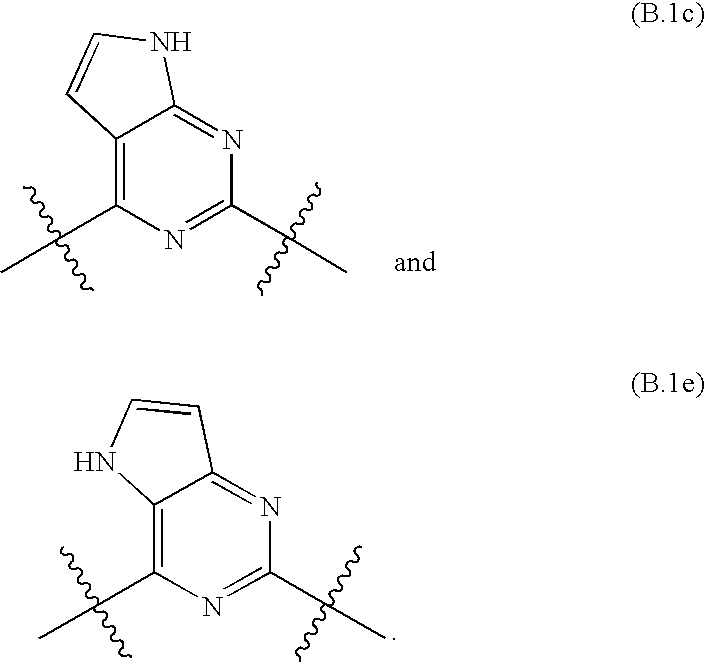Kinase inhibitors and their uses
a kinase inhibitor and inhibitor technology, applied in the field of compounds, can solve the problems of limited angiogenesis (the formation of new blood vessels), unclear literature on the physiological function of axl in vivo, etc., and achieve the effects of inhibiting its activity, low scarring, and preventing diseases
- Summary
- Abstract
- Description
- Claims
- Application Information
AI Technical Summary
Benefits of technology
Problems solved by technology
Method used
Image
Examples
example 1
Synthesis of Racemic 2-Amino-3-dimethylaminocarbonylbicyclo-[2.2.1]hept-5-ene TFA Salt 13
[0275]
To a suspension of N-Boc lactam 10 (1.3 g, 5.52 mmol) in toluene (20 mL) were added 40% methylamine solution in water (3 mL) and p-toluenesulfonic acid monohydrate (70 mg). The reaction mixture was stirred at 100° C. for 17 hours to effect cleavage of the β-lactam ring. The volatiles were evaporated under reduced pressure and the residue was then dissolved in CH2Cl2 (10 mL) Trifluoroacetic acid (TFA, 5 mL) was added and the resulting reaction mixture was stirred at room temperature for 3 hours to remove the Boc-protecting group. The volatiles were evaporated under reduced pressure, and the isolated TFA salt 13 was used in the next step without further purification.
example 2
General Procedure for Synthesis of Purine Mono-SNA, Products
[0276]
[0277]A glass tube was charged with the above amount of TFA salt 13, commercially available 2,6-dichloropurine (1.02 g, 5.43 mmol), N,N-diisopropylethylamine (DIPEA, 3.14 mL, 4.96 mmol) and isopropyl alcohol (IPA, 6 mL). The glass tube was sealed and then shaken at 100° C. for 17 hours. The volatiles were evaporated and the resulting residue was purified by flash chromatography eluting with ethyl acetate-methanol (100:5, including 1% triethylamine) to afford 1.25 g of mono-SNAR product 14, racemic-(2-exo,3-exo-)-N6[3-(dimethylamino)carbonylbicyclo-[2.2.1]hept-5-en-2-yl)]-2-chloro-1H-purine-6-amine, in 70% yield. 1H NMR (300 MHz, CD3OD) δ: 8.05 (s, 1H), 6.35 (m, 2H), 4.68 (m, 1H), 3.00 (s, 1H), 3.04 (s, 1H), 3.00 (s, 3H), 2.95 (s, 1H), 2.83 (s, 1H), 2.68 (s, 3H), 2.39 (d, J=8.7 Hz, 1H), 1.69 (d, J=9.0 Hz, 1H), 1.33 (m, 1H); LC-MS: purity: 90.51%; MS (m / e): 333.43 (M+H)+.
example 3
General Procedure for Synthesis of Second Purine SNAR Products
[0278]
[0279]The mono-SNAR product 14 (40 mg, 0.12 mmol) and 3-isopropoxyaniline (44 ill, 0.3 mmol) were added to a microwave vial, followed by the addition of isopropyl alcohol (IPA, 0.8 mL) and 4 drops of TFA. The mixture was irradiated in a microwave oven at 155° C. for 60 minutes to effect the desired reaction. After cooling the reaction vessel to room temperature, the volatiles were evaporated under reduced pressure. The residue was purified by reverse-phase high performance liquid chromatography (RP-HPLC), eluting with a gradient of acetonitrile-water to provide the desired product 129, racemic-(2-exo,3-exo-)-N6[3-(dimethylamino)carbonylbicyclo[2.2.1]hept-5-en-2-yl)]-N2-(3-isopropoxyphenyl)-1H-purine-2,6-diamine.
PUM
 Login to View More
Login to View More Abstract
Description
Claims
Application Information
 Login to View More
Login to View More - R&D
- Intellectual Property
- Life Sciences
- Materials
- Tech Scout
- Unparalleled Data Quality
- Higher Quality Content
- 60% Fewer Hallucinations
Browse by: Latest US Patents, China's latest patents, Technical Efficacy Thesaurus, Application Domain, Technology Topic, Popular Technical Reports.
© 2025 PatSnap. All rights reserved.Legal|Privacy policy|Modern Slavery Act Transparency Statement|Sitemap|About US| Contact US: help@patsnap.com



